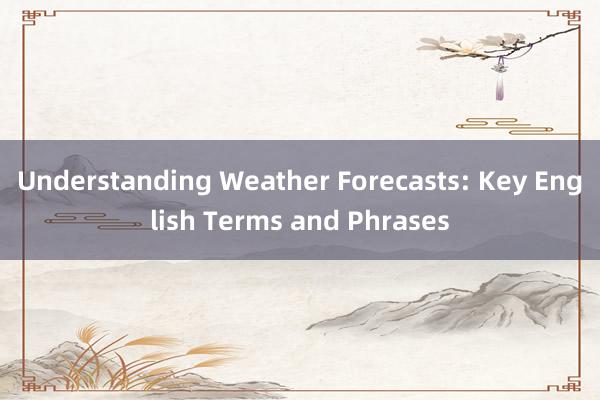时间:2024-10-19 14:23

Weather forecasts are essential tools that help us prepare for the day ahead, plan outdoor activities, or simply stay informed about changes in our environment. However, understanding these predictions can sometimes be challenging, especially when dealing with technical terms and phrases used in English. This article aims to clarify some of the most common terms and phrases you might encounter in weather forecasts.
1. **High Pressure System (高压系统)**: A high-pressure system, often referred to as an anticyclone, is an area where air pressure is higher than the surrounding areas. High-pressure systems are usually associated with clear skies and calm weather conditions.
2. **Low Pressure System (低压系统)**: Conversely, a low-pressure system, also known as a cyclone,海口谊海贸易有限公司 is an area where air pressure is lower than the surrounding regions. Low-pressure systems often bring clouds, 深圳达利达公司 precipitation, 元氧基(北京)生物科技有限公司 and wind.
3. **Fronts (锋面)**: Fronts are boundaries between different air masses, such as cold fronts and warm fronts. Cold fronts occur when a mass of cold air moves into a warmer air region,潮州市鹏远制线实业有限公司 leading to potential thunderstorms. Warm fronts happen when warm air moves over colder air, often resulting in prolonged periods of rain or drizzle.
4. **Precipitation (降水)**: Precipitation refers to any form of water falling from the sky, including rain, snow, sleet, or hail. The amount and type of precipitation are crucial factors in determining how wet or cold it will be.
5. **Humidity (湿度)**: Humidity measures the amount of moisture in the air. High humidity can make hot days feel even hotter due to the difficulty in sweating and cooling down. Conversely, low humidity can make cold days feel less severe.
6. **Visibility (能见度)**: Visibility indicates how far one can see clearly in the atmosphere. It is particularly important for drivers and pilots, as poor visibility can significantly affect safety.
7. **Wind Chill Factor (风寒指数)**: Wind chill factor is a measure of how cold people feel when exposed to wind. Even if the temperature is relatively mild, strong winds can make it feel much colder.
8. **Heat Index (体感温度)**: The heat index combines temperature and humidity to give an accurate measure of how hot it feels. This is crucial for understanding the potential health risks associated with extreme heat.
9. **Dew Point (露点)**: Dew point is the temperature at which air becomes saturated with moisture and begins to condense into dew. Understanding dew points can help predict the likelihood of fog formation or dew.
10. **Forecast Accuracy (瞻望准确性)**: Lastly, it's important to consider the accuracy of weather forecasts. While meteorologists use advanced technology and models, forecasts can still vary in their precision.
By familiarizing yourself with these key terms and phrases, you'll be better equipped to understand and interpret weather forecasts, helping you make informed decisions based on the predicted conditions.